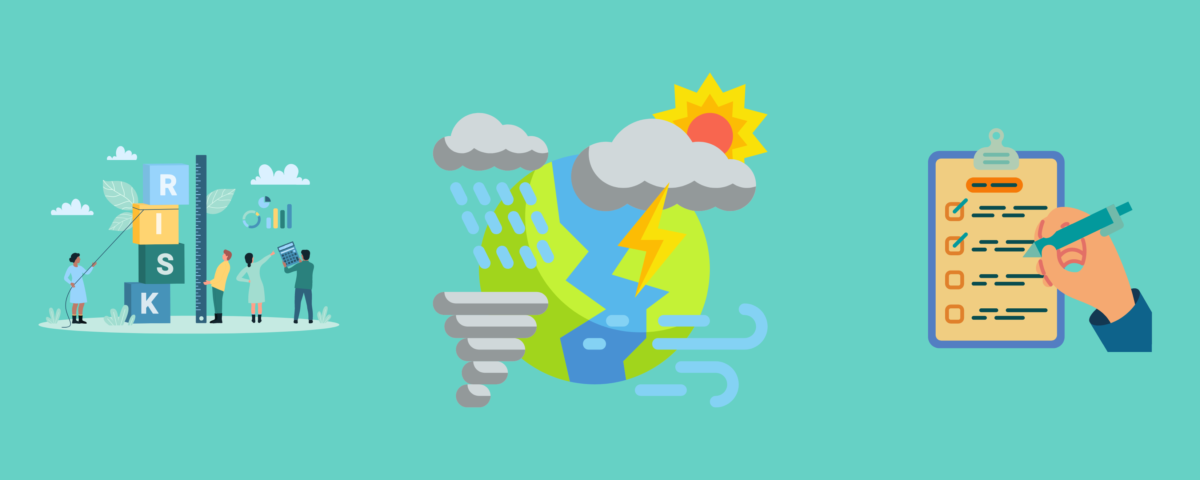
See how Shines Seafood is using ENSO to share their sustainability story
October 26, 2023
Climate Adaptation Planning: Increase Resilience and Uncover Business Opportunities
December 18, 2023As we continue to see the impacts of climate change, new sustainability innovations, updated regulations, and changes in consumer behaviour – new risks may arise for your business. Because of this, it is important to understand what these potential risks may be and which aspects of your business operations may be impacted. Understanding these risks can help you to put a stop to potentially negative situations or mitigate those risks that cannot be avoided.
In this blog, we will talk about the benefits of completing a specific climate risk assessment and share some tips and resources. First, we need to define and understand exactly what a climate risk assessment is in the context of your business and your sustainability journey.
What is a Risk Assessment?
In the past you may have conducted risk assessments for your business. The Federation of Small Businesses defines a risk assessment generally as “the process of identifying, understanding and evaluating potential hazards in the workplace concerning the day-to-day running of a company.” For this blog, we are going to expand this definition to include the assessment of risks that relate directly to climate change and other sustainability related issues.
A climate risk assessment allows you to look at future climate hazards and the potential impacts for your business. Basically, we want to look at all of your business operations, including your value chain and any suppliers or outsourced manufacturing, and identify any new or heightened risks. When conducting your assessment, you’ll want to consider the following:
- Future climate hazards, including storms, high temperatures, and higher sea levels
- Where you are supplying any raw materials, goods, or services, as climate change may cause disruptions or decrease availability
- Current sustainability actions or targets
- Consumer attitudes and behaviours regarding sustainability
- Current and future legislations, regulations, and reporting requirements
- The severity and likelihood of risks that are identified
Why Should You Conduct a Climate Risk Assessment?
The World Economic Forum has identified the failure to adapt to climate change as one of the top three global risks in their 2023 Global Risks Report. This encompasses physical risks as well as risks relating to adaptation and mitigation. These risks include:
- Extreme events causing damage to assets and disrupting operations
- Climate variability influencing costs and trade routes
- Impacts on supply chain availability and costs
- Regulations that require emission reductions
- Changes in energy costs
- Reputational damage from failure to act
Each and every one of the risks listed above have the potential to impact your business. Because of this, it is important to preemptively understand where your operations are vulnerable and to identify potential mitigating actions. When you do this, you are able to have a solid future plan and will more easily be able to withstand climate and economic shocks.
On top of this, as regulations that require reporting become the norm, businesses will be expected to disclose potential areas of risks to their operations. For example, in the Corporate Sustainability Reporting Directive (CSRD) from the EU, companies will be required to complete and report on a double materiality assessment. This means that they will have to discuss both the risks their company activities pose to the environment and the risks they may face due to climate change. To learn more about this, see our blog on the CSRD.
Completing a risk assessment puts you ahead of the game in terms of preparedness and understanding of climate impacts. You will be able to react to future issues and mitigate the worst risks by taking action now to increase and solidify your resilience as a business.
Tips for Carrying Out a Risk Assessment
When getting started with your climate risk assessment, keep in mind these tips:
- Clearly define your scope: Make sure that all team members who are participating in the risk assessment agree on and understand the scope of the project. Your scope should include your entire value chain, but it is up to you how deep you want to go. For example, if you are sourcing packaging like glass jars, you need to decide whether or not to include the raw materials that went into their manufacture in your assessment. You are the expert on your business! Use this knowledge to decide what would be the most useful for you.
- Start big and zoom in: Regardless of your scope, there are many factors to consider when completing a risk assessment. This can be overwhelming and can feel impossible to complete. Our recommendation is to start with a broad, overarching map of your business operations. Once this is complete, identify common risks or opportunities. Next, start zooming in on different aspects of your operations, including your supply chain, in house operations, transport, and customers. You will be able to complete an in depth analysis of each aspect, which will allow you to clearly identify risks and possible mitigation opportunities. Take one piece at a time and before you know it you’ll have a complete assessment!
- Collaborate with multiple stakeholders: A climate risk assessment is a broad undertaking, meaning you’ll need to engage with different stakeholders. Ideally, you can bring together a group of employees from different parts of your business that will head the assessment process. These diverse experiences and perspectives will help to complete a more robust assessment. When necessary, engage with stakeholders outside of your business, like your suppliers and customers, to learn more about the challenges they are facing or the changes they are making.
- Always come back to your risk assessment: As you learn more about climate risks and evolve as a business, always make sure you come back to your completed risk assessment. You can add new insights or opportunities as well as note any risks that have been increased or mitigated. We are all still learning about the exact impacts that climate change will have on business, particularly through new regulations and requirements. Because of this, your risk assessment is a living document that can continue to guide your mitigation and adaptation efforts.
Next Steps After Completing Your Risk Assessment
Once you’ve completed your climate risk assessment, take some time to prioritise your next actions based on your findings. Many of these actions may actually be interesting new business opportunities that you had not considered before. By engaging with them, you are starting your climate adaptation journey. To learn more about how important this is for businesses, check out our blog about climate adaptation planning for businesses!
The more information you can gather about the risks and opportunities your business may face due to climate change, the better prepared you can be. Through innovation and action now, we can mitigate the worst risks and take advantage of new opportunities to grow your business and its resilience.

